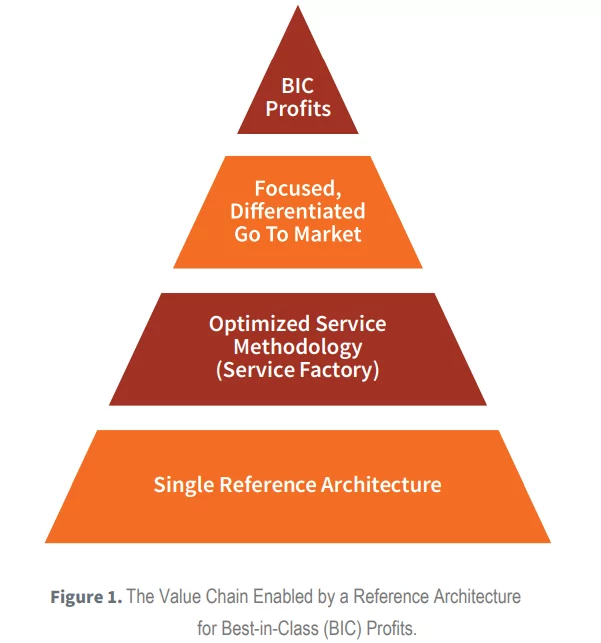
Reference Architecture and its Impact on MSP Maturity, Efficiency, and Profitability
Simply put, a Reference Architecture (RA) is essentially a template for building IT systems. It outlines standard components, their connections, and the best practices for putting them together. This pre-defined structure helps ensure that IT solutions are built efficiently and follow industry standards. This Reference Architecture forms the foundation of a mature MSP’s offering.
Reference Architecture is a single design that spans multiple layers of the technology stack that every IT-using business has implemented: the specific hardware and software products that a given client uses at each layer of its computing infrastructure, from networks to servers to desktops and mobile devices, typically specified by vendor and model number.
The RA also extends to how all these layers are integrated and configured during installation and change management. It further extends into the systems and service management toolset and processes the MSP uses to efficiently manage the infrastructure leveraged from the heart of their operation and out to their clients.
Establishing an RA is a foundational best practice for top quartile-performing MSPs (MSPs) according to NIST. This is especially true with business continuity, where the top performers are taking advantage of the cloud trend to enhance their businesses by utilizing Reference Architecture to design and deliver compelling value to their cloud-first clients.
A reference architecture serves as an MSP blueprint when deploying a new client’s infrastructure to remove the guesswork while also establishing resilience if systems must be rebuilt after a disaster or incident. Reference Architectures can also help MSPs reduce complexity and costs by reducing the number of operational variables that need to be managed.
Why is this Reference Architecture for MSPs important?
Top quartile-performing MSPs are more than twice as profitable as average-performing MSPs, according to nearly every study benchmarking the Solution Provider industry. This large delta in financial performance results partly from their understanding of the value of deploying a single infrastructure design (Reference Architecture) and their ability to enforce its use across most clients. MSPs who have scaled and earned top financial performance have learned the value and the methods of implementing a Reference Architecture.
In Axcient’s White Paper: Reference Architecture Overview for MSPs, we’re discussing this valuable best practice as it applies to picking vendors, utilizing the cloud, and ensuring business continuity.
- Leverage operational efficiencies to gain more leads within a shorter sales cycle, using less overhead while increasing margins and boosting profits.
- Climb the value chain enabled by Reference Architecture from a single-layer foundation to optimized service methodology, differentiated go-to-market, and finally, best-in-class profits.
- Gain insights into the top-performing MSPs by understanding the four most dominant behaviors exhibited when initially defining and maintaining a Reference Architecture.
- Understand the criticality of MSP vendors and see how to choose the right ones to deliver uninterrupted business continuity and goal achievement.
The Value Chain of Reference Architecture
Top-quartile MSPs enforce the use of their RA across the majority of their clients; the highest-performing firms do so across virtually all their clients.

This is evident regardless of whether they choose to pursue the small and midsize businesses (SMB), mid-market, or enterprise market segments, and regardless of geography. Implementing a Reference Architecture improves an MSP’s profitability, scalability, and service quality by reducing the number of operational variables to be managed, thereby reducing complexity and cost across a range of strategic to tactical factors. By limiting vendor and solution sprawl, an MSP has a solid Reference Architecture and more solution mastery with less complexity to manage.
Other reasons to establish an RA for your MSP:
- Agility: Reviewing your RA can help accelerate the deployment of new or best-in-class (BIC) technologies for an intentional mix of use cases and target verticals you support.
- Efficiency: RAs prohibit tech stack sprawl, so your MSP has a tech stack, not a tech sea to drown in.
- Uniformity: A well-thought-through RA will help streamline operations and simplify selling for all-team alignment with organizational goals.
- Scalability: RAs can enable long-term growth and flexibility without excessive complexity and sprawling tools for the team to master.
- Security: Adhering to an intentional security infrastructure increases your team’s security posture and confidence in delivering on SLAs.
- Innovation: RAs can foster innovation and collaboration as you scrutinize and maximize the solutions and infrastructure that best suits your client mix of use cases.
- Cyber insurability: RA can help your MSP meet the requirements to obtain affordable cyber insurance and be paid out if there is an attack.
DOWNLOAD the full guide for MSPs to get all the details on the six behaviors that top-performing MSPs exhibit when initially defining and then maintaining their architecture, learn more about doing it for yourself, and start building your Reference Architecture to meet margin, growth, and profit goals faster and more efficiently.
Get the Guide:

Author
How well could you sleep with reliable cloud-based backups and recovery?
Take a deep dive into Axcient’s proprietary, automated security features to see how we’re ensuring uninterrupted business continuity — no matter what:

